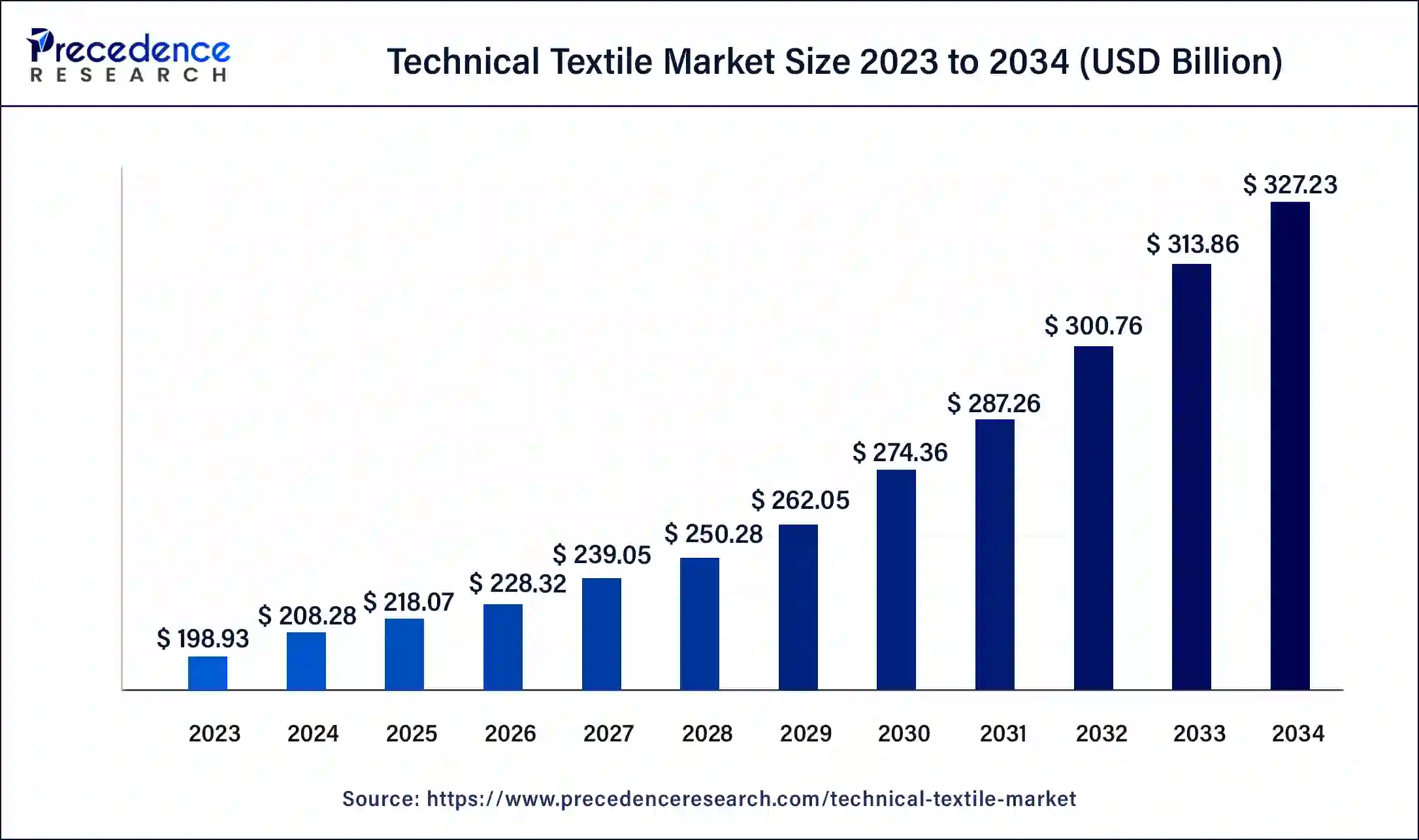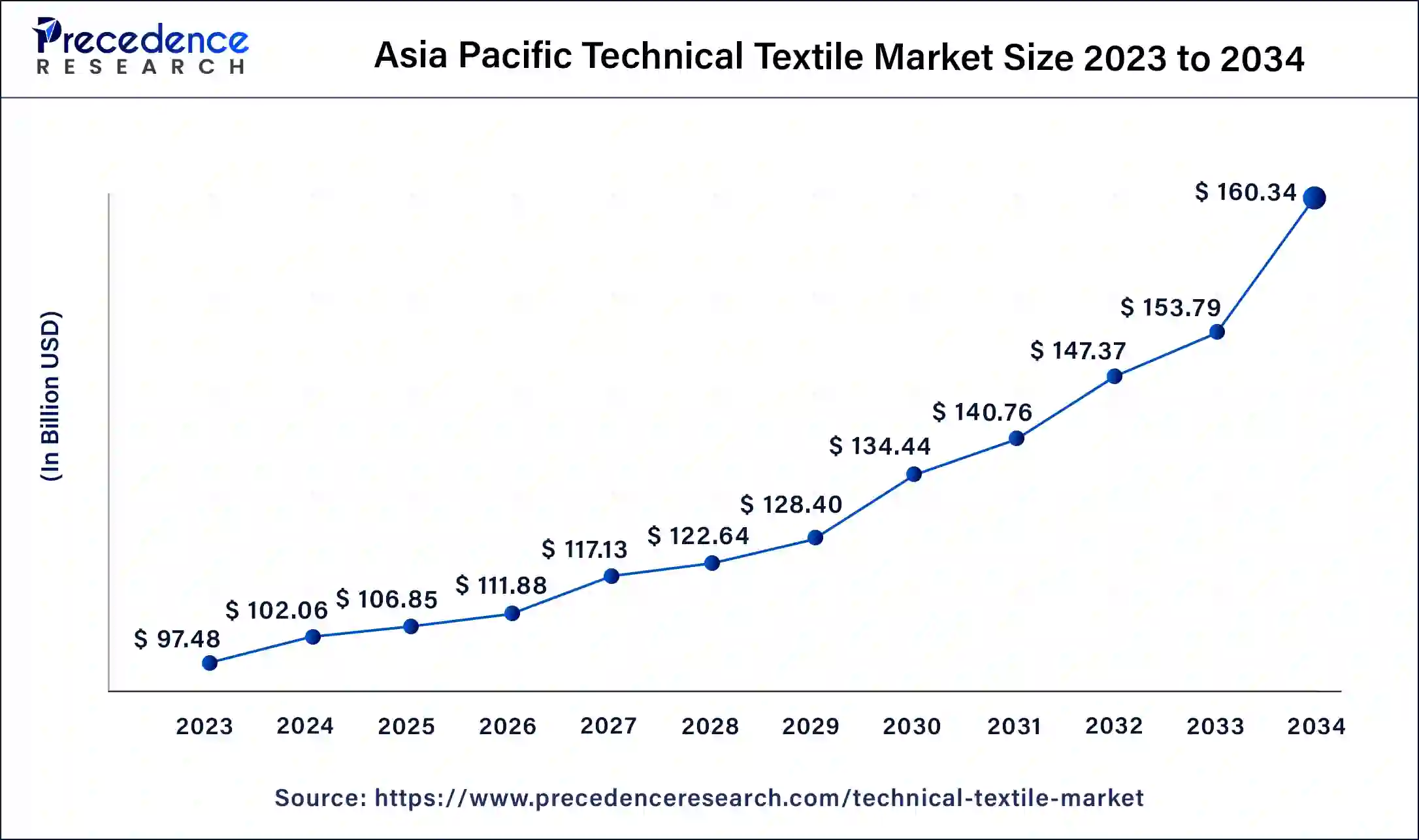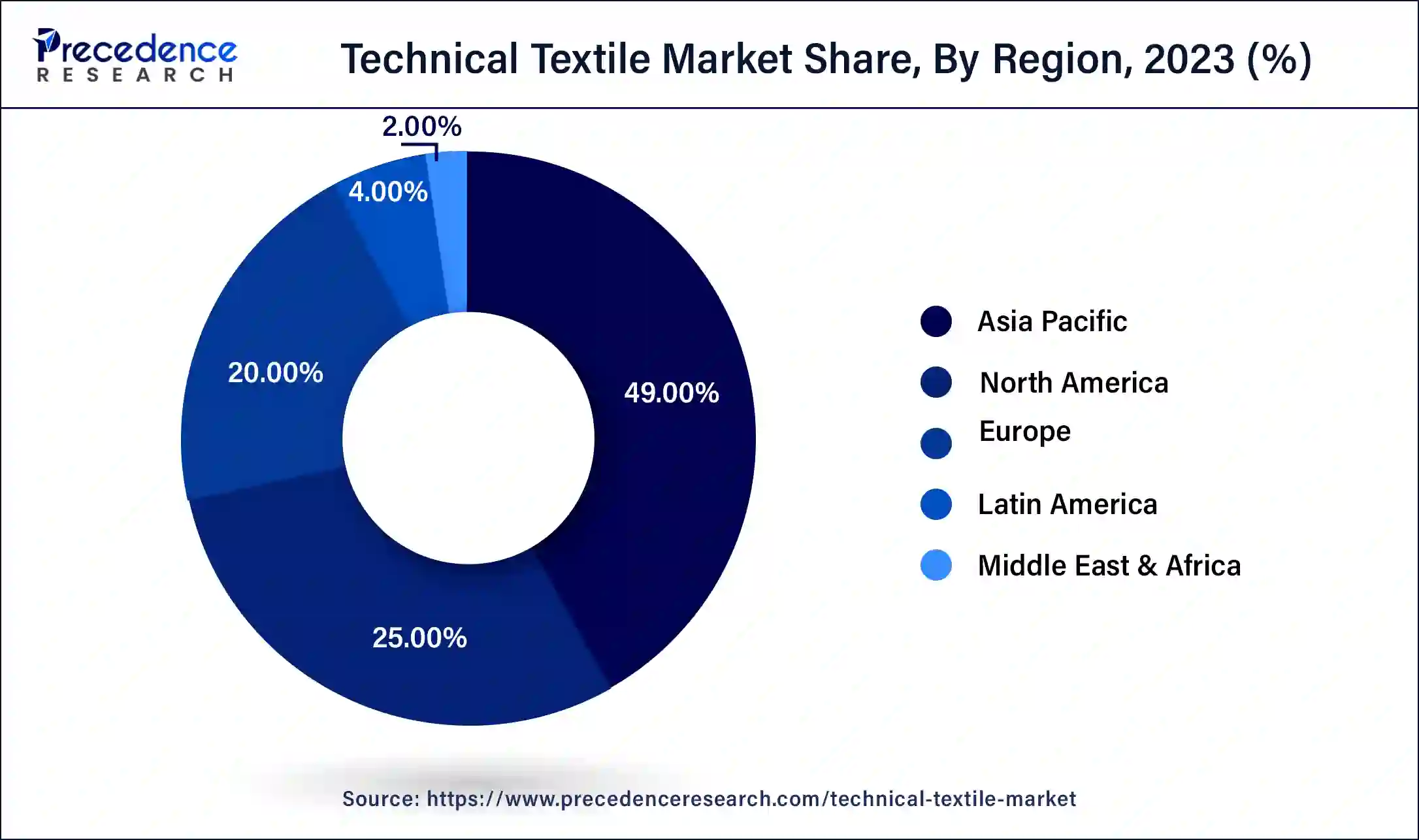List of Contents
What is Technical Textile Market Size?
The global technical textile market size is estimated at USD 218.07 billion in 2025 and is predicted to increase from USD 228.32 billion in 2026 to approximately USD 327.23 billion by 2034, expanding at a CAGR of 5.00% from 2025 to 2034.

Technical Textile Market Growth Factors
Increasing awareness related to the advantages of technical textile projected to impel its demand across several end-use industries that include construction, agriculture, medical, aerospace, and packaging. Innovations in biotechnology have rapidly changed and evolved the traditional farming methods towards more scientific approach. The employment and implementation of highly-advanced technologies in the field of agricultural sector estimated to enhance the crop yield, thereby influencing the total productivity as well as demand for technical textiles.
Furthermore, the increasing application of technical textiles in automobiles and construction sector that include floor covering, rubber, protective gears, flexible reservoirs, and bags & containers used for transportation of critical goods or products, and many more significantly influences the market growth. Increasing application of technical textile is mainly because of its multi-dimensional properties that include high strength, versatility, lightweight, and durability. Thus, the above-mentioned factors are likely to propel the market growth over the upcoming years.
However, the manufacturing cost associated with the technical textiles is higher compared to conventional textiles because of the implementation of advanced and superior raw materials that is likely to impact negatively towards the market growth. In addition, the technology used during the manufacturing of raw materials trailed by their processing as well as final conversion is a costly process that expected to hamper the market growth for technical textiles.
Market Outlook
- Industry Growth Overview: The technical textile market is growing, driven by demand from major sectors such as construction, automotive, and medical. The market significantly focuses on high-performance and functional characteristics, along with technological development and a push toward sustainability.
- Global Expansion: The technical textile market is experiencing global expansion, as technical development, government initiatives, stringent environmental regulations, and the increasing use of sustainable and modern textiles. Asia Pacific is dominated by growing industrialization and economic support from the government.
- Major investors: Major investors in technical textiles include both large international companies, such as DuPont and Freudenberg, as well as major regional players, like Asahi Kasei and Berry Global.
Market Scope
| Report Coverage | Details |
| Market Size in 2025 | USD 218.07 Billion |
| Market Size in 2026 | USD 228.32 Billion |
| Market Size by 2034 | USD 327.23 Billion |
| Market Growth Rate from 2024 to 2034 | CAGR of 5.00% |
| Largest Market | Asia Pacific |
| Base Year | 2024 |
| Forecast Period | 2025 to 2034 |
| Segments Covered | Manufacturing, End-use, and Region |
| Regions Covered | North America, Europe, Asia-Pacific, Latin America, and Middle East & Africa |
Segment Insights
Manufacturing Insights
3D weaving manufacturing technology held a market share of around 24% in 2022 and estimated to register a growth rate of nearly 4.3% between years 2024 and 2034. Significant share of the segment is mainly attributed to the large implementation of 3D weaving manufacturing technology in industries that include medical, agriculture, packaging, industrial, automotive, and aerospace.
On the other hand, 3D knitting manufacturing method helps in monitoring the dimensionality found in knit structures and the 3D shaped weft knitting. In addition, the technology also permits improvements and alterations in the user interface that result in a high-performing and more efficient knit product designs. The above factor anticipated to impel the growth of the 3D knitting technology in technical textile market during the forecast timeframe.
End-use Insights
Home tech textiles segment captured the highest value share of around 20% in 2022 and is projected to grow at a rate of 5.2% during the analysis period. It is mainly used for household applications that include cushion materials, furniture, floor &wall coverings, fireproofing, and textile reinforced structures that deliver comfort, decoration, and safety.
Agro textiles are widely used in agriculture sector because of its functional benefits that include protection from micro-organisms, superior weather resistance, water conservation, and protection from ultra-violet radiation as well as solar radiation. These products provide better crop protection, thereby lead to improved crop quality and increased overall yield.
Regional Insights
Asia Pacific Technical Textile Market Size and Growth 2025 to 2034
The Asia Pacific technical textile market size is valued at USD 106.85 billion in 2025 and is expected to be worth around USD 160.34 billion by 2034, at a CAGR of 5.50% from 2024 to 2034.

Asia Pacific: Increasing demand for functional clothing
The Asia Pacific led the market, accounting for nearly half of the value share in 2024. The dominance of the region expected to continue during the analysis period as well. This is majorly attributed to the increasing demand for functional clothing and apparel in the region. Large consumer base, surge in demand for ethnic wears, and significant impacts of western clothing culture are the major factors that drive the demand for functional clothing in the region.

Furthermore, expansion of commercial, residential, and industrial sectors because of rapid economic growth expected to enhance the construction activities that in turn drive the demand for technical textiles over the upcoming years. In addition, flourishing growth in the tourism industry has impelled the growth of resorts, restaurants, and food chains that again fuel the demand for technical textile in the coming years.
Europe: Increasing research and development (R&D)
On the other hand, Europe examined to register an exponential growth during the analysis period owing to the increasing demand for technical textiles in fashion &clothing and household applications. Additionally, significant growth in medical tourism, healthcare activities, along with growing aging population in the region anticipated to propel the market growth for technical textile in the region.
India: Skilled labor and low costs
India holds a competitive edge through its sizable, affordable labor force and skilled technical workforce. The nation is a leading producer of diverse fibers, notably the world's top cotton producer, securing a reliable supply chain for its textile sector. Government initiatives such as Make in India and the National Technical Textiles Mission are designed to boost manufacturing and export growth.
UK: Advanced manufacturing
UK companies heavily invest in R&D to foster innovation in high-performance materials, such as smart textiles with embedded sensors. A strong emphasis on sustainability, propelled by strict environmental rules and consumer preferences, has positioned them as leaders in eco-friendly materials like biodegradable and recyclable textiles.
North America: Strong manufacturing base
North America is experiencing substantial growth in the market due to its strong, established manufacturing industry, a vibrant research and development (R&D) sector that fosters innovation, and high demand from major industries such as automotive, aerospace, and healthcare. This well-funded R&D sector, supported by top universities and government agencies, continually advances materials and technologies, including smart textiles and high-performance fabrics.
U.S.: Technological Advancements
The U.S. has a broad range of industries that need advanced technical textiles, like aerospace, defense, healthcare, and automotive. This generates dependable demand for novel and high-performance materials. The U.S. has an advanced network of universities, research institutions, and government agencies devoted to advancing textile expertise, which drives the growth of the market.
Value Chain Analysis – Technical Textile Market
- Raw Material: Technical textile raw materials contribute natural fibers such as cotton and jute, synthetic polymers such as polyester, nylon, and polypropylene, and mineral and metal fibers such as glass and steel.
Key Players: DuPont and Asahi Kasei - Chemical Synthesis and Processing : Technical textiles are engineered fabrics intended for particular performance functions, relying massively on specialized chemical synthesis and processing to impart characteristics such as flame resistance, water repellency, and high strength.
Key Players: Berry Global and Freudenberg - Compound Formulation and Blending: A compound formulation combining chemical ingredients to impart specific functional characteristics, such as flame retardancy and UV resistance to the material.
Key Players: 3M and Kimberly-Clark
Top Vendors in the Technical Textile Market & Their Offerings
|
Company |
Headquarters |
Key Strengths |
Latest Info (2025) |
|
B&V Agro Irrigation Co. |
Maharashtra, India |
Diverse product portfolio |
B&V Agro's goal is to offer standard fabrics for protected cultivation |
|
Ludvig Svensson |
Sweden |
Innovation and a dynamic approach |
Svensson specializes in textile climate solutions, giving plants advanced conditions to grow and people better places to work, travel, meet, recover, and study. |
|
Diatex |
France |
Strong Focus on Innovation and R&D |
DIATEX develops fabrics and textile complexes with permanent virucidal properties |
|
Asahi Kasei Advance Corporation |
Japan |
World-leading technological and R&D capabilities |
Asahi Kasei to unveil PFAS-free polyamide and CFRP recycling technology |
|
Mitsui Chemicals, Inc. |
Japan |
World-leading technological and R&D capabilities |
In October 2025, Mitsui Chemicals, Polyplastics announced a partnership regarding marketing operations for engineering plastic products. |
Technical Textile Market Companies
- Gromax Industries
- Huntsman International LLC
- Arrigoni S.p.A.
- Tessitura Boscato S.R.L.
- Hucktek - Huck Nets (UK) Ltd.
- MDB Texinov
- Low & Bonar PLC
- Beniplast Benitex SA
- Freudenberg Group
- Ahlstrom-Munksjo
Recent updates on the technical textile market-2025
Goldwin 0 Introduces Sustainable Performance Wear
- On 2 June 2025, Goldwin 0 launched a futuristic performance capsule made from biodegradable protein fibers and recycled ocean plastics. The designs feature advanced body-mapped ventilation for optimized thermoregulation and comfort. This initiative shows how technical textiles are merging with environmental consciousness and design innovation. (Source: https://www.wallpaper.com)
Battery-Free Smart Textile Interface Revealed by Researchers
- On 13 April 2025, A team of scientists introduced a wireless smart textile that does not require embedded batteries or IC chips. Using resonant coils integrated into fabric, the interface enables passive sensing and energy transmission across garments. This breakthrough could redefine smart clothing by making it lighter, cheaper, and fully washable. (Source: https://arxiv.org)
Goldwin Opens Experimental Technical Textile Factory in Japan
- On 7 June 2025, Goldwin established an innovation center in Toyama, Japan, focused on creating technical fabrics inspired by nature, like slime mold growth patterns. Their research explores fermentation-based fiber production, aiming for zero waste circularity. This marks a step toward commercial bio-fabrication of high-performance apparel. (Source: https://www.wallpaper.com)
Recent developments
- On 15 January 2025, Messe Frankfurt announced hosting of Dorbin Global Fiber Congress Asia at Tech textile India for the first time the prestigious global fiber innovation platform will be held in India. The even aims to foster knowledge sharing on advanced fiber technologies and sustainability's making India a center player in the global technical textile ecosystem. (Source: https://techtextil-india.in.messefrankfurt.com)
- On 9 April 2025, MIT researchers launched a plug-and-play e-knit platform for smart textile prototyping. This innovation allows for rapid integration of sensors into knitted fabrics using magnetic connectors, enabling fast prototyping of wearable electronics. It simplifies development for motion capture, health monitoring, and human-computer interfaces. (Source: https://arxiv.org)
Segments Covered in the Report
By Manufacturing
- 3D Weaving
- Thermo-forming
- 3D Knitting
- Heat-set Synthetics
- Nanotechnology
- Hand-made Elements
- Finishing Treatments
- Others
By End-use
- Buildtech Textiles
- Agro Textiles
- Indutech Textile
- Medtech Textile
- Hometech Textile
- Packtech Textile
- Transtech Textile
- Protech Textile
- Clothtech Textile
- Sportech Textile
- Others
By Region
- North America
- Asia Pacific
- Europe
- Latin America
- Middle East and Africa
For inquiries regarding discounts, bulk purchases, or customization requests, please contact us at sales@precedenceresearch.com
Frequently Asked Questions
Ask For Sample
No cookie-cutter, only authentic analysis – take the 1st step to become a Precedence Research client



